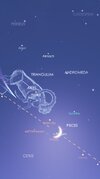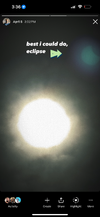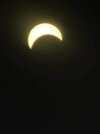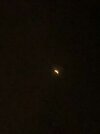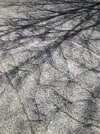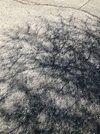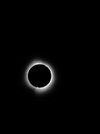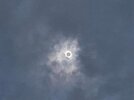You are using an out of date browser. It may not display this or other websites correctly.
You should upgrade or use an alternative browser.
You should upgrade or use an alternative browser.
Coming solar eclipse casts its first U.S. shadow on Eagle Pass, Texas
- Thread starter JGeropoulas
- Start date
Yes, I wonder why Hoagland wants to insist on the remnants of a single dome on the moon. It seems like whoever built these structures had some awesome building techniques with some sort of crystal or glass-like material.@axj I'm not denying the existence of those structures. I've seen convincing arguments for their existence. I'm calling into doubt Hoagland's claim from the podcast Mark7 posted that there is an ancient glass dome surrounding the moon that is mostly eroded. For clarity, "surrounded" as in suspended over the entire atmosphere of the moon, not "surrounded" as in structures all over the surface of the moon.
The eclipse is the calm before the storm...
Sinapi
Dagobah Resident
So, I was in the path of totality over Flyover Country, Missouri, and got to see the eclipse from my house today. It was really cool! The pictures online and on the news don't do it justice. I wasn't planning on seeing it at first because I had a mild case of solar retinopathy several years ago from looking at a partial solar eclipse without glasses (like a moron), but our city was providing the correct glasses for a very low cost and my mom really wanted to see it, so I thought, why not?
We only needed the glasses for the partial portions of the eclipse. At the totality, which I'd say lasted a good 3 minutes, we had to take our glasses off because you can't see anything through them when it gets dark. No chaos, except some cheering from the neighbors, and the robins grew quiet. It was very calm. The eclipse was like a black and white sunflower in a dark sky. I don't know about structures on the moon or a glass dome, but the moon over the sun looked a little shiny, reminiscent of a translucent pearl that you can't see in the pictures. We had some cloud coverage this morning, so perhaps that shininess can be explained by ice crystals or comet dust or just a thin layer of clouds in the atmosphere. We could also see a little blue diamond at the bottom of the moon, and a thin red line at the right edge of the moon. My mom was able to tell when it was about to be over, but I couldn't, so I'm glad I was able to put my glasses back on because it got light almost instantly! We sadly couldn't see any comets or NASA rockets, but it was still a very beautiful sight to see. My eyes are okay!
I thought there might have been some chaos and possible shootings with how hyped people were getting over this, but despite all the tourism, it was really calm. People seemed really happy to be able to get together to see a once in a lifetime event, not just in our town, but in the towns covered by the local news as well. I wouldn't call it life-changing, but still a special moment to see the beauty of Creation.
Anyways, I guess I'll let y'all know if Mothman shows up or if anyone grows three heads.
We only needed the glasses for the partial portions of the eclipse. At the totality, which I'd say lasted a good 3 minutes, we had to take our glasses off because you can't see anything through them when it gets dark. No chaos, except some cheering from the neighbors, and the robins grew quiet. It was very calm. The eclipse was like a black and white sunflower in a dark sky. I don't know about structures on the moon or a glass dome, but the moon over the sun looked a little shiny, reminiscent of a translucent pearl that you can't see in the pictures. We had some cloud coverage this morning, so perhaps that shininess can be explained by ice crystals or comet dust or just a thin layer of clouds in the atmosphere. We could also see a little blue diamond at the bottom of the moon, and a thin red line at the right edge of the moon. My mom was able to tell when it was about to be over, but I couldn't, so I'm glad I was able to put my glasses back on because it got light almost instantly! We sadly couldn't see any comets or NASA rockets, but it was still a very beautiful sight to see. My eyes are okay!
I thought there might have been some chaos and possible shootings with how hyped people were getting over this, but despite all the tourism, it was really calm. People seemed really happy to be able to get together to see a once in a lifetime event, not just in our town, but in the towns covered by the local news as well. I wouldn't call it life-changing, but still a special moment to see the beauty of Creation.
Anyways, I guess I'll let y'all know if Mothman shows up or if anyone grows three heads.

Lukasz
Jedi Master
Obviously there was no eclipse visible in Warsaw, but we also had an interesting, somewhat strange view of the sun today. I am not sure, but there was probably a lot of dust in the air, which made the sun look very faint and white at sunset. I don't think I've ever seen the sun white at sunset, always yellow, orange, red or maybe a little pink, so I thought it was worth mentioning. Here is the photo:

Arlind
Jedi
Was just at this site (blow) and it looks like comet Pons-Brooks will become visible to the naked eye soon. Then, I thought that it might be more visible during the eclipse! The people who have a view of the total eclipse may have an ominous looking sky on Monday!
_Breaking News: Comet 12P/Pons-Brooks Became Much Brighter After an Eruption!
This is what the sky looked like at near totality. The curiously located streak
 underneath Aries is Pons-Brooks. Aries's charging direction looks ominous lol.
underneath Aries is Pons-Brooks. Aries's charging direction looks ominous lol.Also attached, my capture of the 1/3rd eclipse seen here in Calgary
Attachments
Last edited:
Pearce
Jedi Master
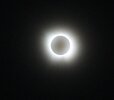
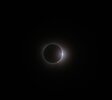
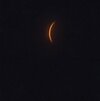
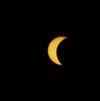
Some pictures from Texas. Was pretty cloudy but got lucky, wish I would have brought my tripod to stabilize a little better. The first two pics (full eclipse) were taken by my aunt, also in Texas. The two partial shots were taken by me.
Was an eerie calm during totality. It got very dark, street lights came on and the air felt very electrified, like just before a storm. We are expecting storms for the next two days so that could have played a part, but it was a neat experience overall.
I was able to listen to a news livestream today at work (don't own a TV, myself). Got a load of nonsense in the report, as if our moon was the only one in the world!. Something was said along the lines of this being the only place in the world where a moon can cross the the path of the sun, and how miraculous was it.
A secret message was seen on the surface of the moon during the eclipse!
nicoleblalonde
Padawan Learner
Here are some photos from where I live, some taken by me at 98% totality and some from friends that drove south to a 100% totality area. The shadows looked really cool during the eclipse so I included pics of them.

Attachments
Here are some photos from where I live, some taken by me at 98% totality and some from friends that drove south to a 100% totality area. The shadows looked really cool during the eclipse so I included pics of them.
View attachment 94124
If you live along the path of totality for Monday's solar eclipse and you have any Christmas or Hanukkah gear, you might want to break it out. The celestial event will bring odd phenomena to our planet — including changes in how people see colors such as red, green and blue.
Here's a look at some of the unusual visual effects a solar eclipse brings to humans on Earth:
Red and green colors will look strange
That's partly due to the change in light when the moon blocks the sun, but also the way our eyes and brain adjust to and interpret that change.
As light dims, our eyes transition from photopic vision, associated with the retina's cone cells that deliver full colors and fine detail, toward scotopic night vision that relies on rod cells to detect objects in low light. In the middle is mesopic vision, the transitional phase where both rods and cones are active.
When the light's intensity dims in the eclipse, colors with longer wavelengths, like red, will look darker as cones become less active. But because rods are sensitive to the shorter blue-green wavelengths, those colors will have a chance to shine.
"This is pretty much a totality thing," Erika Grundstrom, director of astronomy labs at Vanderbilt University, told NPR, with only people in the eclipse's central path guaranteed to witness the phenomenon.
Also, she said, you shouldn't rely on just one red or green T-shirt to trigger the effect.
"You have to have lots of people (or colorful things) around to see it," Grundstrom said via email, adding, "the effect is the result of sudden dimness and your rods and cones trying to make sense of that dimness."
It's called the Purkinje effect.
The what?
The Purkinje effect, aka the Purkinje phenomenon or shift, was documented some 200 years ago by Johannes Evangelista Purkinje, a Bohemian scientist who noticed that when light passed through a prism in dimming conditions, the brightest spot moved — shifting away from red and toward blue, on the shorter end of the wavelength spectrum.
The effect has been studied in the years since — including during the famous 1919 total solar eclipse that gave scientists important observations affirming Albert Einstein's theory of general relativity.
The dimness should become more noticeable about 15 minutes before the eclipse reaches totality. To many people, the light takes on a metallic or silvery quality.
Some shadows will sharpen; others will alter
For one thing, your own shadow will be different.
"The change in lighting makes shadows look sharper on the ground, so it's possible to see individual hairs on your head in your shadow," according to the European Space Agency.
And if you see the sun's light coming through tight gaps in trees, you might notice lots of little crescents. As the ESA says, "The tiny gaps in the leaves will act like multiple pinhole cameras, projecting the Sun's image to the ground."
People in the eclipse's path can also see an odd shimmering called shadow bands.
"A minute or two before totality, ripples of light may flow across the ground and walls as Earth's turbulent atmosphere refracts the last rays of sunlight," as the EarthSky website said in 2017.
Other changes to expect include a drop in temperature — and the appearance of colors in the sky that will make it seem as if you're seeing a sunset (or sunrise) across the full 360 degrees of the horizon.
The miraculous thing about our Moon is that it is 400 times closer to the Earth than the Sun and the Moon's diameter is also 400 times smaller than the Sun at the same time - otherwise total solar eclipses would not be possible. It's a cosmic coincidence that some people even think is proof of intelligent design.Something was said along the lines of this being the only place in the world where a moon can cross the the path of the sun, and how miraculous was it.
spaceweather published a nice view from space of the moon's shadow
"mind-altering"? LOL maybe.NOAA's GOES-16 satellite saw what happened from Earth orbit. The Moon's shadow raced across North America faster than 1500 mph, creating a mind-altering cone of darkness
It was funky!
Where I am we didn't get much darkness at all, but it is always interesting to be in the presence of a partial eclipse, everything looks just really funky from the diffuse lights.
Here's a few of the better tweets I could find from it.
Where I am we didn't get much darkness at all, but it is always interesting to be in the presence of a partial eclipse, everything looks just really funky from the diffuse lights.
Here's a few of the better tweets I could find from it.
Trending content
-
Thread 'Mass Shooting at Bondi Beach, Sydney, targets Jews celebrating Hanukkah'
- Rhythmik
Replies: 139 -
-
Thread 'Coronavirus Pandemic: Apocalypse Now! Or exaggerated scare story?'
- wanderingthomas
Replies: 30K

